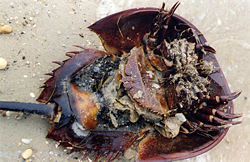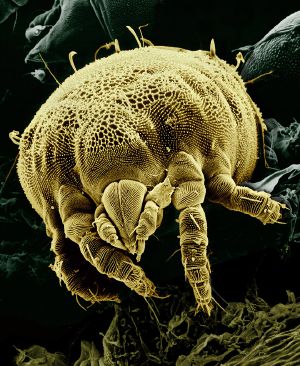Difference between revisions of "Chelicerata" - New World Encyclopedia
({{Contracted}}) |
Rick Swarts (talk | contribs) (added article from Wikipedia and credit/category tag) |
||
| Line 1: | Line 1: | ||
{{Claimed}}{{Contracted}} | {{Claimed}}{{Contracted}} | ||
| + | |||
| + | {{Taxobox | ||
| + | | color = pink | ||
| + | | name = Chelicerata | ||
| + | | image = horseshoe crab female.jpg | ||
| + | | image_width = 250px | ||
| + | | image_caption = [[Horseshoe crab]] | ||
| + | | regnum = [[Animal]]ia | ||
| + | | phylum = [[Arthropod]]a | ||
| + | | subphylum = '''Chelicerata''' | ||
| + | | subphylum_authority = [[Richard Heymons|Heymons]], 1901 | ||
| + | | subdivision_ranks = Classes | ||
| + | | subdivision = [[Arachnida]]<br /> | ||
| + | [[Xiphosura]]<br /> | ||
| + | [[Pycnogonida]]<br /> | ||
| + | †[[Eurypterida]] | ||
| + | }} | ||
| + | |||
| + | The Subphylum '''Chelicerata''' constitutes one of the major subdivisions of the Phylum [[Arthropod]]a, including the [[arachnid]]s, [[horseshoe crab]]s, and related forms. These mainly [[predator|predatory]] arthropods ultimately outlasted the now extinct [[trilobite]]s, the common marine arthropod of the [[Cambrian]] era. Most of the marine chelicerates, including all of the [[Eurypterus|eurypterid]]s, are now extinct. The chelicerates and their closest fossil relatives (mostly originally included in the [[Xiphosura]]) are grouped together with the trilobites to form the [[taxon]] [[Arachnomorpha]]. | ||
| + | |||
| + | ==Characteristics== | ||
| + | In the Chelicerata, the body is divided into an [[anterior]] '''prosoma''' (or [[cephalothorax]]) composed of eight segments plus a presegmental acron and a [[posterior]] '''[[opisthosoma]]''' (or ''abdomen'') composed of twelve segments plus a postsegmental [[telson]]. As in other arthropods, the mouth lies between the second and third segments, but whereas in other groups there is usually a pair of antennae on the last preoral segment, here there are none. The prosoma usually has eyes. The first two segments of the prosoma bear no appendages; the third bears the [[chelicerae]]. the fourth segment bears [[arthropod leg|legs]] or [[pedipalp]]s, and all subsequent segments bear legs. | ||
| + | |||
| + | The chelicerae, which give the group its name, are pointed appendages that grasp the food in place of the chewing mandibles most other arthropods have. Most are unable to ingest anything solid, so they drink blood or spit or inject digestive [[enzyme]]s into their prey. The legs on the prosoma are either [[uniramous]] or have a very reduced [[gill]] branch, and are adapted for walking or swimming. The appendages on the opisthosoma, in contrast, are either absent or are reduced to their gill branch. | ||
| + | |||
| + | ==Classification== | ||
| + | [[Image:Yellow mite (Tydeidae) Lorryia formosa 2 edit.jpg|thumb|Yellow mite<br>''Lorryia formosa'']] | ||
| + | The Chelicerata are divided into four [[Class (biology)|classes]]: | ||
| + | * [[Arachnida]] ([[spider]]s, [[scorpion]]s, [[mite]]s, etc.) | ||
| + | * [[Xiphosura]] ([[horseshoe crab]]s) | ||
| + | * [[Eurypterida]] ([[sea scorpion]]s, extinct) | ||
| + | * [[Pycnogonida]] ([[sea spider]]s) | ||
| + | |||
| + | The Pycnogonida actually show some strong differences from the body plan described above, and it has been suggested that they represent an independent line of arthropods. They may have diverged from the other chelicerates early on, or represent highly modified forms. Sometimes they are excluded from the Chelicerata but grouped with them as the Cheliceriformes. The name [[Merostomata]] should be avoided because in all recent cladistic hypotheses it refers to a [[paraphyletic]] group composed by the Xiphosura + Eurypterida. | ||
| + | |||
| + | The [[Burgess shale]] animal, ''[[Sanctacaris]]'', and perhaps the [[aglaspid]]s, may also belong here. These are extinct forms that arose in the [[Cambrian]], and the aglaspids are believed to have died out during the [[Silurian]]. After them, the oldest group of chelicerates are the [[Eurypterida]], found from the [[Ordovician]] onwards. When young, these show a resemblance to the [[trilobite]]s, suggesting a possible relationship between these two groups. | ||
| + | |||
| + | [[Category:Life sciences]] | ||
| + | [[Category:Animals]] | ||
| + | [[Category:Arthorpoda]] | ||
| + | {{credit|Chelicerata|168081304}} | ||
Revision as of 23:56, 16 November 2007
| Chelicerata | ||||||
|---|---|---|---|---|---|---|
 | ||||||
| Scientific classification | ||||||
| ||||||
|
Arachnida |
The Subphylum Chelicerata constitutes one of the major subdivisions of the Phylum Arthropoda, including the arachnids, horseshoe crabs, and related forms. These mainly predatory arthropods ultimately outlasted the now extinct trilobites, the common marine arthropod of the Cambrian era. Most of the marine chelicerates, including all of the eurypterids, are now extinct. The chelicerates and their closest fossil relatives (mostly originally included in the Xiphosura) are grouped together with the trilobites to form the taxon Arachnomorpha.
Characteristics
In the Chelicerata, the body is divided into an anterior prosoma (or cephalothorax) composed of eight segments plus a presegmental acron and a posterior opisthosoma (or abdomen) composed of twelve segments plus a postsegmental telson. As in other arthropods, the mouth lies between the second and third segments, but whereas in other groups there is usually a pair of antennae on the last preoral segment, here there are none. The prosoma usually has eyes. The first two segments of the prosoma bear no appendages; the third bears the chelicerae. the fourth segment bears legs or pedipalps, and all subsequent segments bear legs.
The chelicerae, which give the group its name, are pointed appendages that grasp the food in place of the chewing mandibles most other arthropods have. Most are unable to ingest anything solid, so they drink blood or spit or inject digestive enzymes into their prey. The legs on the prosoma are either uniramous or have a very reduced gill branch, and are adapted for walking or swimming. The appendages on the opisthosoma, in contrast, are either absent or are reduced to their gill branch.
Classification
The Chelicerata are divided into four classes:
- Arachnida (spiders, scorpions, mites, etc.)
- Xiphosura (horseshoe crabs)
- Eurypterida (sea scorpions, extinct)
- Pycnogonida (sea spiders)
The Pycnogonida actually show some strong differences from the body plan described above, and it has been suggested that they represent an independent line of arthropods. They may have diverged from the other chelicerates early on, or represent highly modified forms. Sometimes they are excluded from the Chelicerata but grouped with them as the Cheliceriformes. The name Merostomata should be avoided because in all recent cladistic hypotheses it refers to a paraphyletic group composed by the Xiphosura + Eurypterida.
The Burgess shale animal, Sanctacaris, and perhaps the aglaspids, may also belong here. These are extinct forms that arose in the Cambrian, and the aglaspids are believed to have died out during the Silurian. After them, the oldest group of chelicerates are the Eurypterida, found from the Ordovician onwards. When young, these show a resemblance to the trilobites, suggesting a possible relationship between these two groups.
Credits
New World Encyclopedia writers and editors rewrote and completed the Wikipedia article in accordance with New World Encyclopedia standards. This article abides by terms of the Creative Commons CC-by-sa 3.0 License (CC-by-sa), which may be used and disseminated with proper attribution. Credit is due under the terms of this license that can reference both the New World Encyclopedia contributors and the selfless volunteer contributors of the Wikimedia Foundation. To cite this article click here for a list of acceptable citing formats.The history of earlier contributions by wikipedians is accessible to researchers here:
The history of this article since it was imported to New World Encyclopedia:
Note: Some restrictions may apply to use of individual images which are separately licensed.
